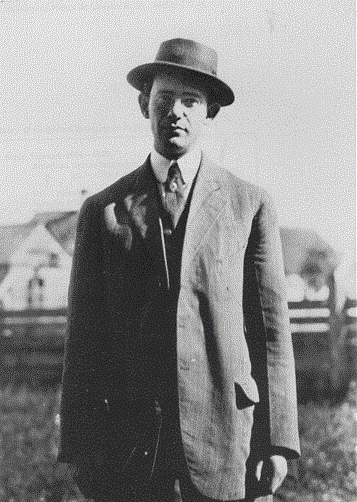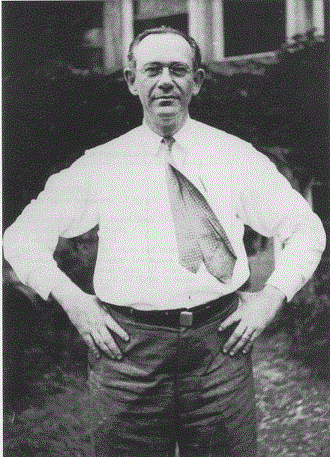<Back to Index>
- Linguist Edward Sapir, 1884
- Writer Ludwig Achim von Arnim, 1781
- General of the United States Army Douglas MacArthur, 1880
PAGE SPONSOR


Edward Sapir (January 26, 1884 – February 4, 1939) was a German born American anthropologist - linguist and a leader in American structural linguistics. His name is borrowed in what is now called the Sapir – Whorf hypothesis. He was a highly influential figure in American linguistics, influencing several generations of linguists across several schools of the discipline.
Sapir was born in Lauenburg in the Province of Pomerania to an orthodox Jewish family. His family immigrated to New York in the United States in 1888.
Sapir earned both a B.A. (1904) and an M.A. (1905) in Germanic philology from Columbia. Among his mentors in Germanics were William Carpenter. His linguistic interests proved to be much broader. In the next two years he took up studies of the Wishram and Takelma languages of Native Americans in southwestern Oregon. In 1909 he received his Ph.D. in anthropology, just emerging as a new field of study. While a graduate student at Columbia, Sapir met his mentor, anthropologist Franz Boas. The latter was likely the person who provided the most impetus for Sapir's study of indigenous languages of the Americas. Boas arranged Sapir's employment in 1907 – 08 researching the nearly extinct Yana language of northern California. Sapir returned there in 1915 to work with Ishi, the monolingual last surviving speaker of Yahi (southern Yana). In the years 1910 – 25 Sapir established and directed the Anthropological Division in the Geological Survey of Canada in Ottawa. When he was hired, he was one of the first full time anthropologists in Canada. Among the many accomplishments of this productive period were a series of substantial publications on Nootka and other languages, and his seminal book Language (1921). Alec Thomas assisted with interviews. It is still important today and accessible to educated lay people. As Sapir left for a teaching position at the University of Chicago, one of the few research universities then in the United States, he enabled Leonard Bloomfield to obtain support from Ottawa to do fieldwork on Cree language. This was essential to Bloomfield's project of historical reconstruction in Algonquian languages. From 1931 until his death in 1939, Sapir taught at Yale University,
where he became the head of the Department of Anthropology. He was one
of the first to explore the relations between language studies and
anthropology. His students included Fang - kuei Li, Benjamin Whorf, Mary Haas, and Harry Hoijer. Sapir came to regard a young Semiticist named Zellig Harris as his intellectual heir, although Harris was never a formal student of Sapir. (For a time he dated Sapir's daughter.) Sapir also exerted influence through his membership in the Chicago School of Sociology, and his friendship with psychologist Harry Stack Sullivan. Some
of Sapir's suggestions about the influence of language on the ways in
which people think were adopted and developed by Whorf. They both
believed that stimulating and challenging theories would attract
students to this fledgling field. During the 1940s and later, this
concept became known as the Sapir – Whorf Hypothesis. Late work of Harris supported their hypothesis. Sapir's special focus among American languages was in the Athabaskan languages, a family which especially fascinated him: "Dene is probably the son - of - a - bitchiest language in America to actually know... most fascinating of all languages ever invented." Sapir also studied the languages and cultures of Wishram Chinook, Navajo, Nootka, Paiute, Takelma, and Yana. His research on Southern Paiute, in collaboration with consultant Tony Tillohash, led to a 1933 article which would become influential in the characterization of the phoneme. Although noted for his work on American linguistics, Sapir wrote prolifically in linguistics in general. His book Language provides everything from a grammar - typological classification of languages (with examples ranging from Chinese to Nootka) to speculation on the phenomenon of language drift, and the arbitrariness of associations between language, race, and culture. Sapir was also a pioneer in Yiddish studies (his first language) in the United States (cf. Notes on Judeo - German phonology, 1915). Sapir was active in the international auxiliary language movement.
In his paper "The Function of an International Auxiliary Language", he
argued for the benefits of a regular grammar and advocated a critical
focus on the fundamentals of language, unbiased by the idiosyncrasies
of national languages, in the choice of an international auxiliary
language. He was the first Research Director of the International Auxiliary Language Association (IALA), which presented the Interlingua conference in 1951. He directed the Association from 1930 to 1931, and was a
member of its Consultative Counsel for Linguistic Research from 1927 to
1938. Sapir consulted with Alice Vanderbilt Morris to develop the research program of IALA.